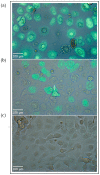From Submerged Cultures to 3D Cell Culture Models: Evolution of Nasal Epithelial Cells in Asthma Research and Virus Infection
- PMID: 33670992
- PMCID: PMC7997270
- DOI: 10.3390/v13030387
From Submerged Cultures to 3D Cell Culture Models: Evolution of Nasal Epithelial Cells in Asthma Research and Virus Infection
Abstract
Understanding the response to viral infection in the context of respiratory diseases is of significant importance. Recently, there has been more focus on the role of the nasal epithelium in disease modeling. Here, we provide an overview of different submerged, organotypic 3D and spheroid cell culture models of nasal epithelial cells, which were used to study asthma and allergy with a special focus on virus infection. In detail, this review summarizes the importance, benefits, and disadvantages of patient-derived cell culture models of nasal- and bronchial epithelial cells, including a comparison of these cell culture models and a discussion on why investigators should consider using nasal epithelial cells in their research. Exposure experiments, simple virus transduction analyses as well as genetic studies can be performed in these models, which may provide first insights into the complexity of molecular signatures and may open new doors for drug discovery and biomarker research.
Keywords: 3D cell culture; air–liquid-interface; asthma; bronchial epithelial cells; culture techniques; epithelial cells; nasal epithelial cells; spheroids; submerged; virus.
Conflict of interest statement
The authors declare no conflict of interest. The funders had no role in the design of the study; in the collection, analyses, or interpretation of data; in the writing of the manuscript, or in the decision to publish the results. FP receives royalties from Elsevier for the 24th Ed. of the anatomy atlas “Sobotta” and the “Sobotta Textbook of Anatomy”. The German Research Foundation that supported FP (PA738/15-1) had no role in the design or conduct of this research.
Figures



Similar articles
-
Nasal Mucociliary Epithelial Cell Culture Models for Studying Viral Infections.Methods Mol Biol. 2025;2890:237-252. doi: 10.1007/978-1-0716-4326-6_13. Methods Mol Biol. 2025. PMID: 39890731
-
Tropism and Infectivity of a Seasonal A(H1N1) and a Highly Pathogenic Avian A(H5N1) Influenza Virus in Primary Differentiated Ferret Nasal Epithelial Cell Cultures.J Virol. 2019 May 1;93(10):e00080-19. doi: 10.1128/JVI.00080-19. Print 2019 May 15. J Virol. 2019. PMID: 30814288 Free PMC article.
-
A toolbox for studying respiratory viral infections using air-liquid interface cultures of human airway epithelial cells.Am J Physiol Lung Cell Mol Physiol. 2021 Jul 1;321(1):L263-L280. doi: 10.1152/ajplung.00141.2021. Epub 2021 May 19. Am J Physiol Lung Cell Mol Physiol. 2021. PMID: 34010062
-
Primary airway epithelial cell culture and asthma in children-lessons learnt and yet to come.Pediatr Pulmonol. 2015 Dec;50(12):1393-405. doi: 10.1002/ppul.23249. Epub 2015 Jul 14. Pediatr Pulmonol. 2015. PMID: 26178976 Review.
-
Air-liquid interface (ALI) impact on different respiratory cell cultures.Eur J Pharm Biopharm. 2023 Mar;184:62-82. doi: 10.1016/j.ejpb.2023.01.013. Epub 2023 Jan 22. Eur J Pharm Biopharm. 2023. PMID: 36696943 Review.
Cited by
-
The Communication between Ocular Surface and Nasal Epithelia in 3D Cell Culture Technology for Translational Research: A Narrative Review.Int J Mol Sci. 2021 Nov 30;22(23):12994. doi: 10.3390/ijms222312994. Int J Mol Sci. 2021. PMID: 34884799 Free PMC article. Review.
-
High-throughput bioprinting of the nasal epithelium using patient-derived nasal epithelial cells.Biofabrication. 2023 Aug 14;15(4):044103. doi: 10.1088/1758-5090/aced23. Biofabrication. 2023. PMID: 37536321 Free PMC article.
-
Air exposure and cell differentiation are essential for investigation of SARS-CoV-2 entry genes in human primary airway epithelial cells in vitro.Front Med (Lausanne). 2022 Sep 6;9:897695. doi: 10.3389/fmed.2022.897695. eCollection 2022. Front Med (Lausanne). 2022. PMID: 36148455 Free PMC article.
-
Establishment of sheep nasal mucosa explant model and its application in antiviral research.Front Microbiol. 2023 May 15;14:1124936. doi: 10.3389/fmicb.2023.1124936. eCollection 2023. Front Microbiol. 2023. PMID: 37256060 Free PMC article.
-
Human Species D Adenoviruses Isolated from Diarrheal Feces Show Low Infection Rates in Primary Nasal Epithelial Cells.Children (Basel). 2021 Jun 30;8(7):563. doi: 10.3390/children8070563. Children (Basel). 2021. PMID: 34208817 Free PMC article.
References
Publication types
MeSH terms
LinkOut - more resources
Full Text Sources
Other Literature Sources
Medical

